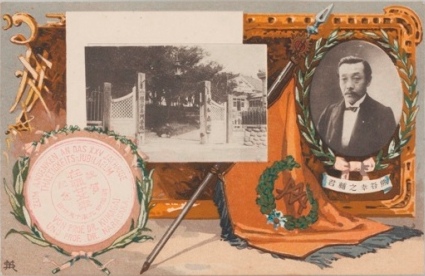 |
The Medical Museum of Nagoya University is located on the fourth floor of the Medical Library. It collects, preserves, and exhibits antique medical books, historical medical instruments, photographs and other items to promote understanding of the history of the Nagoya University School of Medicine in the context of the Tokai district and to look forward to the future of medical science. Parts of the collections can be accessed through the Digital Archive. Registration at the Medical Library counter is required for the actual use of these materials. |
|
8. From Aichi Prefectural Medical College to Nagoya Medical College |
|
|
 |
KUMAGAI Konosuke
Strength is found in adversity and, following the outcry over the possible sale of the school and hospital, the management situation of both gradually improved and the system was strengthened remarkably. In Meiji year 26 (1893), upon the closing of Aishu Gakko, which acted as a preparatory institute for the School, a preparatory course (200-person capacity, two-year course) was added , and in Meiji year 27 (1894) an affiliated midwife and nurse's training school (one-year course) was also established. The formation of the Aichi Medical Science Association with the School at its center and the publication of the first "Aichi Igakkai Zasshi (Aichi Medical Science Association Journal)" that year indicates the School's awareness that, even at that time, it was not merely a facility for training physicians but an academic institution.
|
KUMAGAI was meditating on a grand plan: "Aichi Medical School should be upgraded to a university when the second university is established in Japan" (MORI Ogai); and, at the beginning of the Meiji year 30s, he strove to further reinforce the school's system with a team of 22 teachers, including 14 graduates from Tokyo University.
In addition, while in office KUMAGAI sent as many as 12 of his teachers overseas for two to three years on long-term study abroad. Also, the research done during this time by KAWAHARA Hiroshi on "Naika Iko (Internal Medicine): Nervous System Edition" and by ISHIMORI Kuniomi on soporific substances is highly valued even today.
In Meiji year 34 (1901), the medical faculties of five national higher schools in Chiba, Sendai, Okayama, Kanazawa and Nagasaki separated to become national medical colleges. The School had to tread a thorny path, separate from these five national schools, from the early 20s of Meiji until the early Showa period; this was probably due to the extremely uneven dispersion of the five-district system under the "Middle School Ordinance" proclaimed in Meiji year 19 (1886), in which no national higher school medical faculty was based in the center of the Chubu area. In Meiji year 36 (1903), Imperial Ordinance No. 48 was abolished and the "Specialized College Ordinance" was proclaimed. The School was then re-launched as the Aichi Prefectural Medical College, and new regulations were established. Persons who passed college qualifying exams were added to candidates for the entrance examination, and the students stepped out proudly in their college caps. Graduating students were entitled to call themselves "Aichi Medical College diploma holders", and the institution entered an era that would draw a line between medical school and college.
Between the end of the Meiji 30s and the beginning of the 40s, an otorhinolaryngology department, dermatology and venereal diseases department, neuropsychiatry department and surgery III (orthopedic surgery) department were established one after another, and in Meiji year 43 (1910) a two-year graduate course was added, all of which contributed to the enormous enrichment of education, practice and services at both the college and the hospital.In Meiji year 35 (1902) the college was inspected by Minister of Education KIKUCHI, who severely declared that "the building is the shabbiest in Japan", though he rated the content of the college's education as qualifying it for university status; he pressed for the rebuilding of the college and hospital. After this, with the consent of the prefectural assembly, a new school building and hospital were finally completed in the Tsurumai area twelve years later, in Taisho year 3 (1914). The buildings' majestic 26,000-square meter appearance demonstrated the college's ambition and intention to raise itself to university status. KUMAGAI, who finished this construction endeavor, retired in Taisho year 6 (1917) due to illness, after dealing with the hard task of managing the college and hospital for 36 years.
The college was shocked by the news that five national medical colleges were planning to be promoted to medical universities according to the "University Ordinance" and the higher education expansion program of Taisho year 7 (1918). It decided not to shift to the government-run institution and instead, as a first step, achieved its transition to a medical college run by Aichi Prefecture, ahead of the national medical colleges' promotion to national medical universities, in Taisho year 9 (1920). |
|
|
|
|